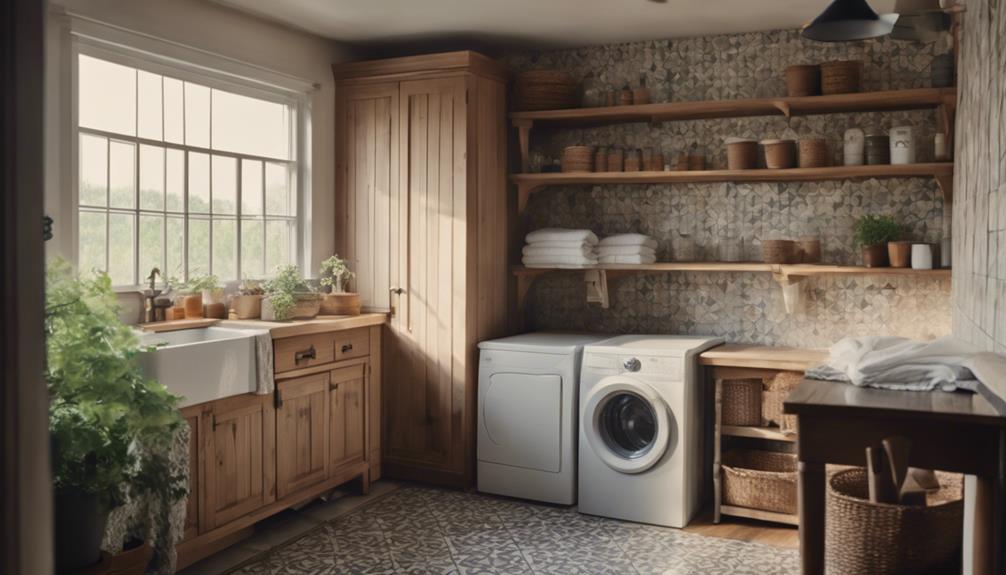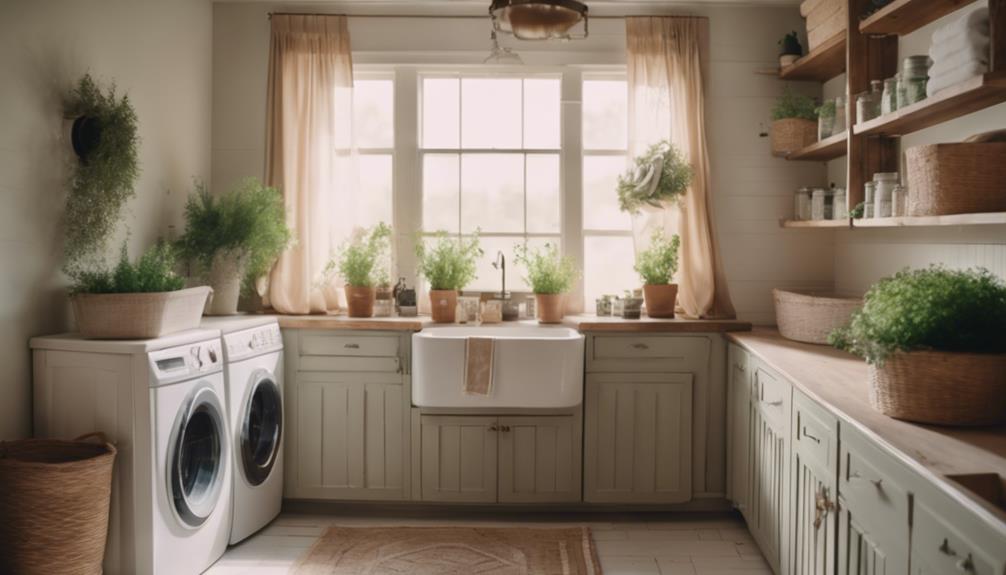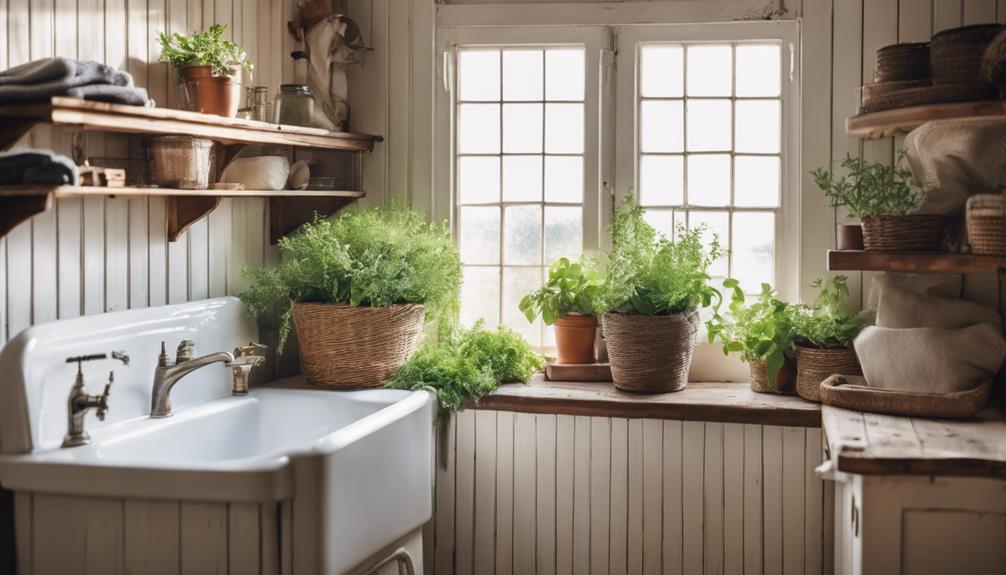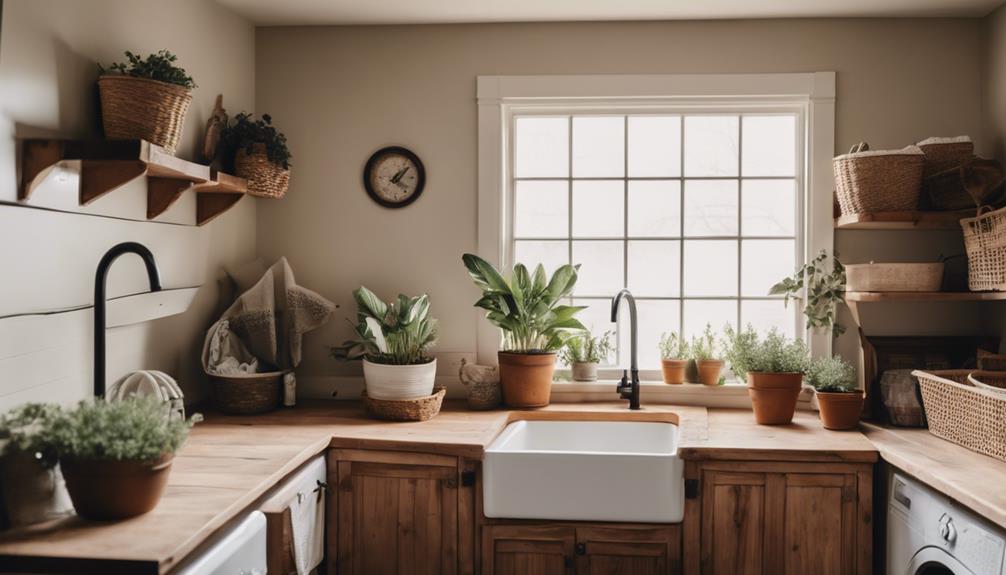Creating a stylish farmhouse laundry room helps make your chores feel less tedious by combining style with functionality. Incorporating built-in shelves and labeled bins for organized storage is key. Multi-functional furniture, like benches with hidden compartments, maximizes space while keeping essentials accessible. Don’t forget to include a stylish farmhouse sink, rustic materials, and a neutral color palette for a warm atmosphere. Adding decorative touches, such as houseplants or vintage signs, boosts the room’s charm. By organizing efficiently and using smart solutions, you’ll transform this space into a stylish haven. Curious about more ideas? There’s plenty more to inspire your dream laundry room!
Key Takeaways
- Incorporate built-in shelves and labeled bins for organized storage, enhancing functionality and accessibility in your laundry room.
- Use rustic materials like reclaimed wood and shiplap for a warm and inviting farmhouse aesthetic.
- Include multi-functional features such as a laundry sink or a craft station to maximize utility and versatility.
- Maintain a neutral color palette with soft tones to create a calming environment that complements farmhouse decor.
Storage Solutions and Organization
Maximizing storage and organization in your farmhouse laundry room is essential for reducing clutter and streamlining your chores. Start by incorporating effective storage solutions like built-in shelves and cabinets. These features not only provide ample space for laundry essentials but also keep everything neatly tucked away, enhancing your laundry room design.
Consider adding labeled baskets or bins for easy identification of supplies. This simple organization tip guarantees you can quickly grab what you need, making laundry day much more efficient. You might also think about multi-functional furniture, such as benches with hidden storage, which can save space while adding aesthetic appeal.
Installing a pull-out drying rack and a hidden ironing board can further enhance functionality, allowing you to air-dry garments and complete ironing tasks without sacrificing precious space.
Regular decluttering and maintaining a cleaning schedule will help you keep your laundry room organized and stylish over time. By focusing on these storage solutions and organization strategies, you'll create a functional space that makes your chores feel less intimidating and more manageable.
Multi-Functional Uses and Utility Features

A farmhouse laundry room can transform into a versatile space, serving not only for washing clothes but also as a utility hub for various household tasks. By incorporating a laundry sink, you gain a practical area for washing larger items, caring for pets, or cleaning supplies, making your chores a breeze.
If you convert part of your laundry room into a mudroom, you'll enhance functionality by providing designated storage for shoes, sports gear, and outdoor clothing, all while keeping your home organized. Adding a craft or wrapping station can further maximize utility, allowing you to tackle DIY projects or gift wrapping without cluttering other areas of your home.
Utilizing energy-efficient appliances in your laundry room not only reduces utility costs but also promotes a sustainable lifestyle, which is increasingly important today. Plus, integrating smart home technology can elevate your laundry experience, enabling you to remotely monitor and control your appliances for greater convenience and efficiency.
Design Elements and Inspirations

When designing your farmhouse laundry room, consider incorporating rustic materials like wood and metal for a cozy feel.
A neutral color palette can enhance the calming atmosphere while still allowing for vintage decor accents.
Together, these elements create a charming and functional space that reflects the farmhouse aesthetic beautifully.
Rustic Material Incorporation
Incorporating rustic materials like reclaimed wood and shiplap can instantly transform your laundry room into a warm and inviting farmhouse space. Shiplap walls not only add texture but also create a classic backdrop that harmonizes beautifully with other rustic elements. Consider using reclaimed wood for shelves or countertops; it enhances the farmhouse aesthetic while infusing warmth and character.
To elevate the overall design, opt for vintage-style fixtures and hardware, such as wrought iron or brass handles, which bring an authentic touch. These details can tie all your rustic materials together, creating a cohesive look.
Additionally, combining natural materials like metal and wood in functional items—think drying racks or storage baskets—will reinforce that rustic theme. Don't forget to incorporate decorative elements like antique washboards or old laundry tools.
These charming accents reflect the history and utility of the space, making it feel lived-in and inviting. By thoughtfully selecting and incorporating these rustic materials, you'll not only enhance functionality but also create a stylish laundry room you'll love spending time in.
Neutral Color Palettes
Neutral color palettes consistently create a serene atmosphere in farmhouse laundry rooms, making them feel inviting and stylish. By choosing soft whites, grays, and beiges, you can achieve a calming environment that enhances the rustic charm of farmhouse style.
Here are three ways to effectively incorporate neutral color palettes in your laundry room:
- Subway Tile Accents: Use white subway tiles with gray grout to add visual interest without straying from the neutral theme. This combination keeps your space bright and cohesive.
- Natural Wood Counters: A wood counter complements the neutral palette beautifully, adding warmth and a touch of nature that fits perfectly within the farmhouse aesthetic.
- Muted Color Pops: Introduce accents of muted colors, like dusty blues or sage greens, to your decor. These subtle touches can add depth without overwhelming the serene feel of the room.
Decorative Touches and Aesthetic Enhancements

Bright paint or wallpaper instantly transforms a farmhouse laundry room, creating an inviting and cheerful atmosphere. Choose vibrant colors or playful patterns that reflect your style and set a positive tone for the space.
To enhance both organization and aesthetics, incorporate decorative storage containers. They keep your supplies neatly arranged while adding a stylish touch to your room.
Adding houseplants introduces a fresh and lively element, bringing a natural vibe into your laundry area. Consider easy-to-care-for options like succulents or pothos, which thrive in various lighting conditions.
Vintage signs or quotes can personalize your laundry room, infusing character and charm that resonate with the farmhouse aesthetic. Look for pieces that reflect your personality or convey a whimsical message.
Practical Tips for Efficiency

To make your laundry room more efficient, focus on smart organization solutions and workflow strategies.
You can create dedicated spaces for sorting and folding, which helps reduce clutter and speeds up the process.
Smart Organization Solutions
Maximize your laundry room's efficiency with smart organization solutions that keep supplies neatly stored and easily accessible. Here are three effective strategies to implement:
- Built-in cabinetry: Install cabinets and shelves to create designated spaces for laundry essentials. This keeps everything organized and reduces clutter, allowing you to find what you need quickly.
- Multi-functional furniture: Choose benches with storage compartments or tables that can double as folding stations. This not only saves space but also adds functionality, making laundry tasks easier.
- Storage bins and baskets: Use labeled bins to categorize items like detergents, fabric softeners, and dryer sheets. This simple solution helps you identify what you need in a snap, streamlining your laundry process.
Don't forget to include pull-out drying racks and hidden ironing boards to keep your space tidy.
Regularly declutter and reassess your storage solutions to adapt to your family's changing needs.
With these laundry room ideas, you'll create a functional and stylish environment that enhances your laundry experience.
Efficient Workflow Strategies
Streamlining your laundry workflow can turn a tedious chore into a more efficient and manageable task. Start with a laundry room remodel that maximizes counter space. A clear, spacious area makes sorting and folding clothes easier. Incorporate a designated folding table to streamline post-wash organization and reduce clutter during laundry tasks.
Utilize shelves above the laundry for storage; label bins and containers clearly to facilitate quick access to laundry essentials like detergents and fabric softeners. This way, you won't waste time searching for items when you're ready to wash.
Consider adding pull-out drying racks to maximize space and efficiency, allowing garments to air dry without taking up valuable floor space. Establishing a cleaning schedule helps manage laundry loads effectively, ensuring you wash, dry, and fold at regular intervals throughout the week.
If possible, create a mudroom area within your laundry space to store shoes and sports gear. This keeps your laundry room organized and accessible, reducing mess and improving your overall workflow.
With these strategies in place, you'll find that laundry day becomes much less of a chore!
Charming Farmhouse Features

Incorporating charming features like shiplap walls and a farmhouse sink instantly transforms your laundry room into a cozy, functional space. These elements not only enhance the aesthetic but also create a warm atmosphere you'll love spending time in.
Here are three key features to evaluate:
- Farmhouse Sink: This centerpiece serves as a practical workspace while adding a stylish touch to your laundry room, resembling beautiful furniture.
- Shiplap Walls: The rustic charm of shiplap walls adds texture and character. Whether painted in soft tones or left natural, they offer a timeless appeal that complements other farmhouse elements.
- Open Shelving: This feature provides easy access to laundry essentials and allows you to showcase decorative items like baskets and faux plants, enhancing the overall decor with a personal touch.
Don't forget to sprinkle in some vintage decor, like antique barn doors or nostalgic cleaning tools, to add character and warmth.
Shopping Sources for Essentials

Finding stylish storage solutions and decorative accents for your farmhouse laundry room can elevate both its functionality and charm. Consider incorporating woven baskets or vintage metal bins for storing laundry essentials, while also adding a touch of rustic flair to the space. To maximize organization and enhance the aesthetic, a farmhouse entertainment center can serve as a multi-functional piece, offering storage for laundry supplies, as well as a place to display decorative pieces or hold a folding table for added convenience. With the right storage solutions and decorative accents, your farmhouse laundry room can become a stylish and inviting space that makes chores feel less like work.
Start by exploring home decor retailers for decorative hand towels that add a cozy touch to your space. You'll find a variety of patterns and textures that fit perfectly with the farmhouse aesthetic.
For practical organization, look for stylish lint boxes that can be hung on cabinet doors, ensuring you have quick access while keeping your laundry rooms neat. Metal boxes designed for laundry pods and dryer sheets not only enhance functionality but also maintain an appealing look.
To simplify your laundry tasks, consider fabric softener pumps that make dispensing liquid softeners a breeze.
Don't forget about under-sink organization! Wire baskets and shelving options are excellent choices for maximizing storage without compromising style. These solutions seamlessly blend practicality and aesthetic appeal.
With a little shopping, you can create a farmhouse laundry room that's both functional and inviting, making laundry day feel a bit less like a chore. So, get out there and find the essentials that fit your vision!
Frequently Asked Questions
What Size Should a Farmhouse Laundry Room Be for Optimal Functionality?
For ideal functionality, your laundry room should be at least 5 feet wide and 8 feet long. This space lets you move around easily, store supplies, and incorporate essential appliances without feeling cramped.
How Can I Incorporate Farmhouse Style in a Small Laundry Space?
Imagine a cozy, rustic retreat; you can incorporate farmhouse style in your small laundry by using shiplap walls, vintage baskets for storage, distressed wooden shelves, and soft, neutral colors to create warmth and charm.
What Flooring Options Are Best for a Farmhouse Laundry Room?
For your laundry room, consider durable options like vinyl planks or ceramic tiles. They're easy to clean and come in various styles, giving you that farmhouse feel while standing up to moisture and wear.
How Do I Maintain a Clean and Organized Laundry Area?
To maintain a clean and organized laundry area, you should regularly declutter, establish designated spaces for items, use baskets for sorting, and wipe down surfaces frequently. These habits make laundry day more efficient and enjoyable.
Can I Add Natural Light to a Basement Laundry Room?
When it comes to adding natural light to your basement laundry room, you can't judge a book by its cover. Consider installing windows, using glass block, or even a light tube to brighten the space.
Conclusion
Incorporating a farmhouse laundry room isn't just about functionality; it's where style meets utility.
Imagine stepping into a space that's both practical and inviting—wouldn't that make laundry feel less like a chore?
By blending smart storage, charming design elements, and those unique touches, you can transform your laundry routine into a delightful experience.
So, why settle for ordinary when you can create a space that inspires?
Immerse yourself in your farmhouse journey and watch your laundry room come to life!









